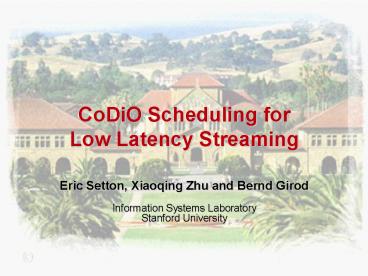CoDiO Scheduling for Low Latency Streaming - PowerPoint PPT Presentation
1 / 21
Title:
CoDiO Scheduling for Low Latency Streaming
Description:
... the framework to video streaming. Large gains compared to sequential ... Setton, Zhu & Girod: CoDiO Scheduling for Low Latency Streaming. CoDiO vs. RaDiO ... – PowerPoint PPT presentation
Number of Views:26
Avg rating:3.0/5.0
Title: CoDiO Scheduling for Low Latency Streaming
1
CoDiO Scheduling for Low Latency Streaming
- Eric Setton, Xiaoqing Zhu and Bernd Girod
- Information Systems Laboratory
- Stanford University
2
Presentation Outline
- Congestion-distortion optimized (CoDiO)
scheduling - Motivation
- Description of the algorithm
- Low-complexity CoDiO scheduling
- Application of CoDiO scheduling
- Sender-receiver wired network
- Sender-receiver multihop wireless adhoc network
3
Related Work
- TCP-friendly rate-control
- Indicates average rate as a function of collected
statistics - Does not indicate any particular schedule
- Rate-Distortion Optimized Scheduling
- Formalization of the multimedia scheduling
problem - Adapted the framework to video streaming
- Large gains compared to sequential scheduler
Floyd et al., 1997
Chou and Miao, 2001
Chakareski and Girod, 2002-5
Kalman and Girod 2003-5
4
Parameterized Delay Distribution
C
delay
5
Congestion-Distortion Optimized Scheduling
- Congestion used as a new metric
- Adaptive to network conditions
- Reflects the impact of a sender
- Blows up close to capacity
- Principle of CoDiO
Decide which packets to send (and when) to
maximize picture quality while minimizing
network congestion
6
Predicting Video Distortion
- Probability of packet arrival may be estimated by
a parameterized delay distribution - Compute expected distortion of each frame
P
P
I
P
P
P
Kalman, Ramanathan and Girod, 2003
7
Estimating Self-Congestion
- Congestion defined as average end-to-end delay
R(t4)
R(t3)
decrease rate C, the capacity
R(t0)
R(t1)
Size of the bottleneck queue
average queue size
8
Finding the Best Transmission Order
- Optimal schedule is
- Why is this difficult ?
- Large search space
- Tight coupling between schedules
- How to solve this problem ?
9
Find a Good Schedule at Random!
P
I
B
P
P
B
B
10
Low Complexity CoDiO Scheduler
- Select iteratively most important video packet to
transmit or retransmit - Space transmissions to limit congestion over
bottleneck - Sufficiently simple to be run at each node
11
Wired Network Scenario
Random cross traffic
High bandwidth links
Low bandwidth uplink
Video traffic
C
Acknowledgments
12
CoDiO Scheduling Performance
Mother Daughter sequence
News sequence
30
25
Simulations over ns-2 Packet loss rate
2 Bandwidth 400 kb/s Propagation delay 50ms
13
CoDiO
ARQ
H.264 _at_250 kb/s Bandwidth 400 kb/s 2 packet
loss0.6 sec latency
14
CoDiO vs. RaDiO
40
Sequence Mother Daughter Packet loss rate
2 Bandwidth 400 kb/s Propagation delay 50ms
15
Wireless Network Scenario
- 15-node wireless network simulated in ns-2
- Mobile nodes, speed 2.5 m/s
- 802.11b MAC protocol, ad hoc mode
- DSR routing
- 1 sender-receiver pair
- Receiver sends ACKs
- Video streaming
- Foreman CIF sequence, encoded with H.264
- 4 encoding rates
- 915 kbps, 495 kbps, 275 kbps, 120 kbps
- I B B P coding structure, GOP length 15
- Short playout deadlines between 350 ms and 700 ms
- Previous frame concealment
16
Network simulation
17
Scheduling Schemes
- CoDiO light TFRC throughput estimator
- TFRC estimator determines how to select the rate
- CoDiO light scheduler controls transmissions and
retransmissions - Sequential scheduling TFRC throughput estimator
- Quality is determined similarly as in the other
scheme - Retransmission based on fixed timeout
18
Performance ComparisonLoss Rate
19
Performance ComparisonVideo Quality
20
450 ms playout deadline
Sequential 35 dB
CoDiO light 37 dB
21
Summary
- Presented the idea of CoDiO scheduling
- Extended the scheduling framework to
throughput-limited network - New metric Lagrangian cost of congestion and
distortion - Simple CoDiO-light scheduler
- Determines the best packets to send
- Adaptive to varying network conditions
- Outperforms sequential scheduler































